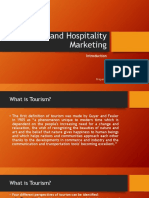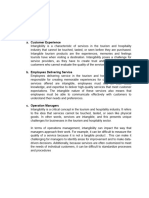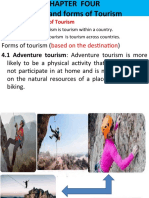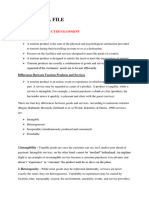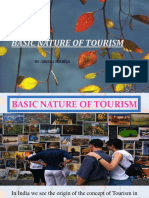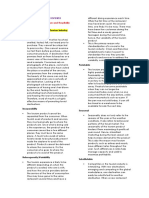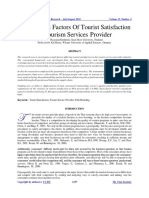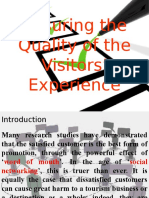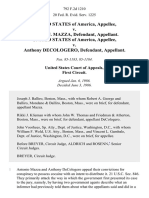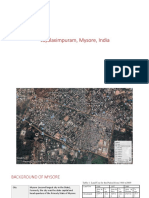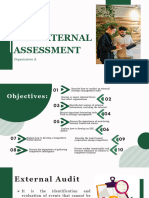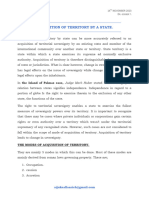BangaBandhu Sheikh MujiBur rahMan Science and
Technology univerSiTy
A Lab Report
On
Qualitative and Quantitative analysis
Course Title: Qualitative and Quantitative analysis
Course code: THM562
Submitted to: Submitted by:
Rubaiyat Shabbir Md. Sohorab Hosen
ID No: 17THM031
Assistant Professor
MBA Session: 2021-2022
Department of Tourism and Hospitality Department of Tourism & Hospitality
Management Management
Bangabandhu Sheikh Mujibur Rahman Bangabandhu Sheikh Mujibur Rahman Science
Science and Technology University and Technology University
Date of Submission: 18 November 2024
1|Page
�Introduction (Paraphrased)
With oceanic economic activities expected to double by 2030 and significant growth in the scale
and diversity of ocean industrialization, interest in this domain has surged, alongside growing
concerns about its sustainability. The concept of the "blue economy" arises from this heightened
interest, aiming to recognize and assess the breadth of economic activities that utilize ocean
resources. It seeks to integrate fundamental principles of policy and planning while measuring
these activities' impacts against sustainability objectives. Tourism, which has long-standing
economic ties to oceanic environments, plays a critical role in this framework. Coastal areas,
among the earliest and most popular destinations, have significantly influenced the tourism
industry’s evolution, with new technologies unlocking more oceanic territories for exploration.
Research on sustainable marine tourism highlights its dual capacity to foster human-ocean
relationships, drive innovation, promote ocean stewardship, and, conversely, exploit and colonize
resource-rich territories. Tourism’s significant footprint across coastal, oceanic, and inland
waterways underscores its vital role in shaping the blue economy. However, challenges remain in
defining and measuring the blue economy and mitigating its risks to sustainability, leaving
tourism’s exact roles and implications within this framework ambiguous.
The United Nations’ blue economy framework emphasizes two primary elements: identifying
oceanic and inland water territories and embedding sustainability principles in economic activities.
Beyond these, the concept remains subject to interpretation and ongoing refinement. As a relatively
recent term, the blue economy is still evolving, including how tourism and related research fit into
it. While many concerns of the blue economy align with existing marine tourism scholarship, the
consolidation of this concept offers opportunities to expand tourism studies and enhance
understanding of planning, governance, and the dynamics of tourism in aquatic environments.
Despite humanity’s longstanding relationship with oceanic economies, this new era of rapid
economic activity introduces both opportunities and constraints, facilitating the emergence of new
political organizations and institutions (Ertör and Hadjimichael, 2020, p. 2).
Driven by the depletion of terrestrial resources due to unsustainable practices and the significant
ecological changes impacting oceanic environments (Voyer et al., 2018), the blue economy’s role
in sustainable development is increasingly critical. It is not only pivotal in maintaining current
lifestyles and demands but also in exploring innovative ways to harmonize economic activities
with natural resource management.
0|Page
�Question:1
What are the Non-quantitative factors in valuing a business?
Non-quantitative factors in valuing a business are intangible elements that do not directly appear
on financial statements or involve measurable numerical data but significantly influence a
business's worth. These factors focus on qualitative aspects of a business, such as its reputation,
operational efficiency, culture, and future potential, rather than purely financial metrics like
revenue or profit margins. In the tourism industry, non-quantitative factors are especially crucial
because the sector relies on experiences, relationships, and perceptions. Factors like destination
appeal, cultural significance, and service quality often outweigh numerical data when determining
value.
Example: A tour operator offering unique, community based experiences may hold higher
perceived value than a competitor with higher profits but no distinct offerings.
By recognizing and leveraging non-quantitative factors, businesses in the tourism industry can
achieve a more comprehensive and realistic valuation, ensuring both tangible and intangible assets
are considered.
Key Aspects of Non-quantitative Factors
A. Intangible Value
These factors often relate to the company's brand relationships, or market positioning, which can
provide competitive advantages.
Example: A strong brand name like Marriott in the hospitality sector.
B. Qualitative Impact
Unlike quantitative factors, which are measurable (e.g., earnings or market share), non-
quantitative factors assess qualities such as employee skills, customer loyalty, or leadership style.
C. Subjective Nature
Evaluating non-quantitative factors often involves subjective judgment, requiring a deep
understanding of the business and industry.
Page | 1
�Examples of Non-quantitative Factors
Brand Reputation
Customer Experience and Satisfaction
Location and Accessibility
Employee Skills and Morale
Cultural and Social Impact
Regulatory and Legal Environment
Sustainability Practices
Partnerships and Alliances
Market Position and Competitive Advantage
Crisis Management Capability
1. Brand reputation
Brand reputation in the tourism industry is critical because it directly influences customer trust,
loyalty, and booking decisions. It encompasses several factors that determine how a business is
perceived in the market. Here's a detailed breakdown of the key brand reputation factors connected
to the tourism industry:
i. Customer Reviews and Testimonials
Impact: Online reviews and personal testimonials are pivotal in shaping public opinion. Platforms
like Trip Advisor, Google Reviews, and Booking.com allow travelers to share experiences that
influence potential customers.
Example: A hotel with consistent 5star reviews and positive feedback about cleanliness, service,
and location is more likely to attract bookings.
ii. Quality of Service
Impact: The level of customer service provided by tourism businesses significantly impacts their
reputation. Guests expect professionalism, friendliness, and efficiency.
Example a tour operator known for punctuality, knowledgeable guides, and personalized
itineraries will build a strong reputation.
Page | 2
� iii. Consistency and Reliability
Impact: Delivering a consistent experience across multiple locations or over time helps maintain a
strong brand reputation.
Example: International hotel chains like Marriott or Hilton are trusted because customers expect
and receive a certain standard regardless of the location.
iv. Awards and Accreditations
Impact: Recognition from industry bodies or awards for excellence boosts credibility.
Example: A resort winning an ecotourism award gains prestige and attracts environmentally
conscious travelers.
v. Social Media Presence
Impact: Active engagement on social media platforms allows businesses to showcase their
offerings, respond to feedback, and connect with customers in realtime.
Example: An Instagramworthy boutique hotel that frequently shares appealing images and
interacts with followers can build a positive brand image.
vi. Employee Behavior and Professionalism
Impact: Employees are the face of a tourism business, and their attitude and professionalism
directly influence customer experiences.
Example: Courteous and helpful staff at a tourist information center enhance the overall perception
of the destination.
vii. Sustainability Practices
Impact: Modern travelers increasingly value businesses that prioritize sustainability and ethical
practices.
Example A safari lodge that conserves wildlife habitats and supports local communities earns
respect and loyalty from environmentally conscious tourists.
Page | 3
�viii. Marketing and Branding Efforts
Impact: Effective marketing campaigns and a clear brand message help shape how a business is
perceived in the competitive tourism market.
Example: A luxury cruise line with a tagline emphasizing opulence and exclusivity ensures all
branding efforts align with that promise.
Non-quantitative factors in valuing a business refer to aspects that are not easily measured in
financial terms but significantly impact a business's worth. In the tourism industry, these factors
are especially crucial due to the industry's reliance on service quality, brand reputation, and
customer experience. Here's a detailed explanation:
2. Customer Experience and Satisfaction
Explanation: High levels of customer satisfaction often lead to repeat business and wordofmouth
referrals.
Connection to TourismIn the tourism sector, personalized service, seamless experiences, and
exceptional customer care define a business's longterm success.
3. Location and Accessibility
Explanation: The geographical location of a business can influence its attractiveness and
profitability.
Connection to Tourism: Hotels, resorts, and attractions in prime locations (e.g., near beaches,
mountains, or historical sites) have higher intrinsic value, even if their immediate profitability is
low.
4. Employee Skills and Morale
Explanation Skilled and motivated employees can enhance service quality and operational
efficiency.
Connection to Tourism Tour guides, hospitality staff, and other frontline employees directly affect
guest experiences, making their attitude and skills critical.
Page | 4
� 5. Cultural and Social Impact
Explanation: How a business aligns with cultural and social values can affect its acceptance in the
community.
Connection to Tourism: Ecotourism businesses, for example, gain value by promoting
sustainability and respecting local cultures.
6. Regulatory and Legal Environment
Explanation: Adherence to laws, regulations, and ethical standards can enhance a business's
operational stability and public trust.
Connection to Tourism: Compliance with environmental laws, safety standards, and tourism
policies can make a business more reliable and sustainable.
7. Sustainability and Environmental Practices
Explanation: Increasing emphasis on sustainability adds value to businesses committed to
environmentally friendly operations.
Connection to Tourism: Green tourism and ecofriendly lodging options are highly valued by
environ4mentally conscious travelers.
8. Market Position and Competitive Advantage
Explanation: A business's ability to stand out among competitors is a major factor in its longterm
viability.
Connection to Tourism: Unique experiences, such as niche tours or exclusive services, can enhance
a business’s desirability.
9. Partnerships and Alliances
Explanation: Strategic partnerships can open new markets and create synergies.
Connection to Tourism: Collaborations with airlines, travel agencies, or local governments can
increase a tourism business's value.
Page | 5
� 10.Crisis Management Capability
Explanation: The ability to handle crises (natural disasters, pandemics, etc.) can determine a
business's resilience.
Connection to Tourism: In a sector vulnerable to external shocks, businesses with robust
contingency plans are more attractive.
In summary, nonquantitative factors are vital in the tourism industry as they directly impact
customer experience, community relations, and the business's adaptability to dynamic market
conditions. While these factors don't appear on financial statements, they significantly contribute
to the longterm success and perceived value of tourism enterprises.
Why Nonquantitative Factors Matter in Valuing a Business
LongTerm Sustainability
Intangibles often contribute to the business's ability to remain competitive over time.
Example: A resort with sustainable practices attracts ecotourists, ensuring future relevance.
Market Differentiation
Unique nonquantitative factors can justify a higher valuation.
Example: A boutique hotel known for personalized customer service.
Risk Mitigation:
Strong employee morale, customer loyalty, and reputation reduce risks during market
downturns.
Enhancing Negotiations:
Highlighting nonquantitative strengths can help secure better terms during mergers,
acquisitions, or investments.
Page | 6
�Question:2
The state of research methodologies in the tourism industry has evolved significantly, with both
qualitative and quantitative methods being widely used. However, qualitative research has gained
considerable attention in recent years for its ability to capture indepth, contextual, and complex
insights about tourist behavior, experiences, and perceptions. Here's a breakdown of the current
state of research methodologies, focusing on qualitative research in the tourism industry:
1. Current State of Research Methodologies in the Tourism Industry
Research in the tourism industry has seen a shift toward a more interdisciplinary approach, drawing
from fields such as anthropology, sociology, psychology, economics, and marketing. Both
qualitative and quantitative methodologies are applied, depending on the research objectives.
Quantitative Research: This is still prominent in tourism research, particularly in areas like
market segmentation, tourist behavior analysis, and impact assessment. Common techniques
include surveys, statistical modeling, and experiments.
Qualitative Research: While traditionally seen as more subjective, qualitative research is now
viewed as essential for understanding the nuances of human experience. It focuses on exploration,
interpretation, and deeper meaning.
Mixed Methods Approach: A growing trend in tourism research is the integration of qualitative
and quantitative approaches to provide a fuller picture of tourism phenomena. This approach helps
triangulate data and enhances the robustness of findings.
2. Qualitative Research in the Tourism Industry
Qualitative research has become central in tourism studies due to its capacity to explore the
meanings and experiences tourists attribute to their travel. It's often used to answer "why" and
"how" questions, as opposed to the "how much" or "how many" questions that quantitative
research tends to address.
Page | 7
�Key Qualitative Research Methods Used in Tourism Studies:
Interviews: Semi structured or unstructured interviews are commonly used to explore tourists'
personal narratives, motivations, and emotional experiences. Researchers might conduct
interviews with tourists, tourism stakeholders, or local residents.
Example: A study might involve indepth interviews with ecotourists to understand their
motivations for visiting sustainable destinations and how they define "ecofriendly tourism."
Focus Groups: Group discussions can provide insights into tourists' attitudes and collective
perspectives. Focus groups allow for an exchange of ideas and can reveal shared experiences or
contradictions.
Example: Focus groups with cultural tourists could explore their perceptions of cultural
authenticity in heritage sites, examining how they perceive the preservation or commercialization
of culture.
Participant Observation: Researchers immerse themselves in tourist environments to observe
behaviors, interactions, and rituals without directly interfering. This method helps understand the
context and naturalistic aspects of tourist experiences.
Example: An ethnographic study where a researcher participates in communitybased tourism
activities to understand local residents’ perspectives on hosting tourists and the challenges they
face.
Content Analysis: Analyzing texts, media, social media posts, or marketing materials is a method
used to identify patterns, themes, and sentiments related to tourism.
Example: Analyzing social media posts and travel blogs to study how tourists construct and
communicate their travel narratives about a specific destination.
Page | 8
� Case Studies: In-depth investigation into specific destinations, tourism businesses, or tourism
related issues. These allow researchers to develop detailed insights into particular phenomena and
contexts.
Example: A case study of a city’s tourism development strategy could examine how a
destination managed a surge in visitors and balanced local needs with tourist expectations.
Recent Examples of Qualitative Research in Tourism:
1. Tourist Motivation and Experience: A qualitative study explored why tourists visit a
particular destination, not only based on demographic data but also through their emotions and
personal reflections. For example, a study on "nostalgic tourism" focused on people visiting their
childhood homes or past vacation spots. Researchers used interviews to understand how these
places served as emotional anchors.
2. Cultural and Heritage Tourism: Research on cultural tourism often uses qualitative methods
like interviews with tourists and local heritage site managers to understand perceptions of
authenticity. A study might explore how tourists feel about the preservation of indigenous cultures
in an area and how their engagement influences local traditions and economies.
3. Tourism and Sustainability: With a growing emphasis on sustainable tourism, qualitative
research has been used to examine the experiences of tourists engaging in ecofriendly tourism
practices. For example, researchers have used interviews and participant observation to explore
Eco tourist’s perceptions of the environmental impact of their travels and how they define
responsible tourism.
4. Dark Tourism: This is an emerging area of qualitative research where scholars explore why
people visit sites associated with death, disaster, or tragedy. Qualitative methods, particularly
interviews and ethnography, have been used to understand the psychological and emotional
experiences of dark tourists.
Page | 9
�Challenges of Qualitative Research in Tourism:
Subjectivity and Bias: Since qualitative research is interpretive, there is a potential for researcher
bias. This makes it crucial for researchers to be transparent about their methods and interpretations.
Data Generalization: Qualitative research typically involves smaller sample sizes, which may
limit the ability to generalize findings across larger populations. However, it provides deep insights
that are often more meaningful than large scale statistical data.
Time Consuming: Qualitative research often involves labor intensive processes such as data
collection (interviews, field observations) and analysis (coding and theming), which can be time
consuming.
Ethical Issues: In tourism research, particularly with marginalized or vulnerable communities,
researchers need to be sensitive to ethical concerns, including issues of consent, privacy, and
exploitation.
3. Conclusion
The tourism industry has embraced qualitative research due to its ability to capture the complex,
subjective aspects of tourism experiences, which are often missed by quantitative studies. As
tourism becomes more diversified, qualitative methods are becoming essential for understanding
the multifaceted nature of travel, from emotional experiences to cultural interactions. The
integration of qualitative insights with quantitative data offers a holistic view that benefits tourism
planning, marketing, and management.
Page | 10


















